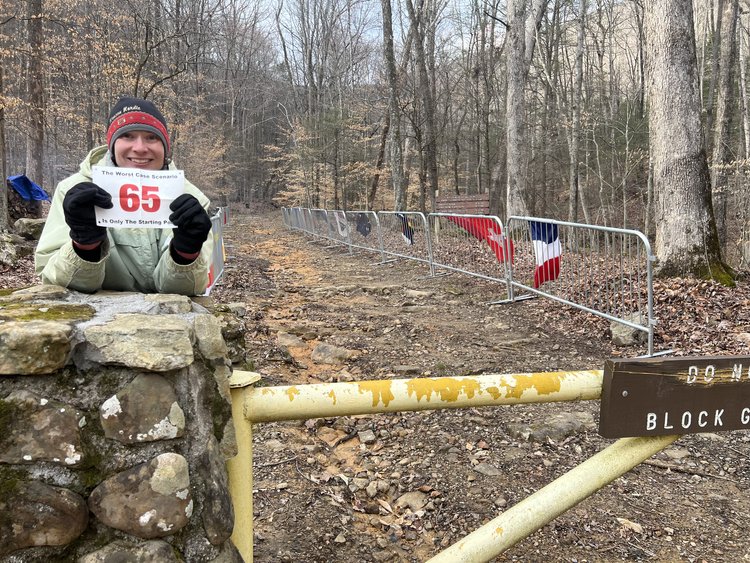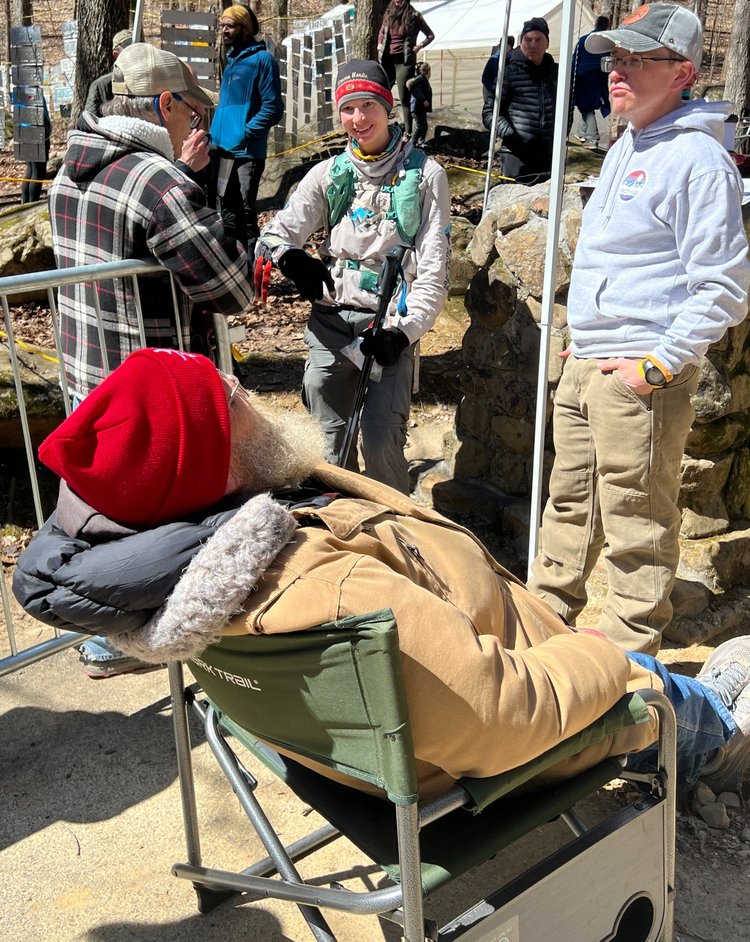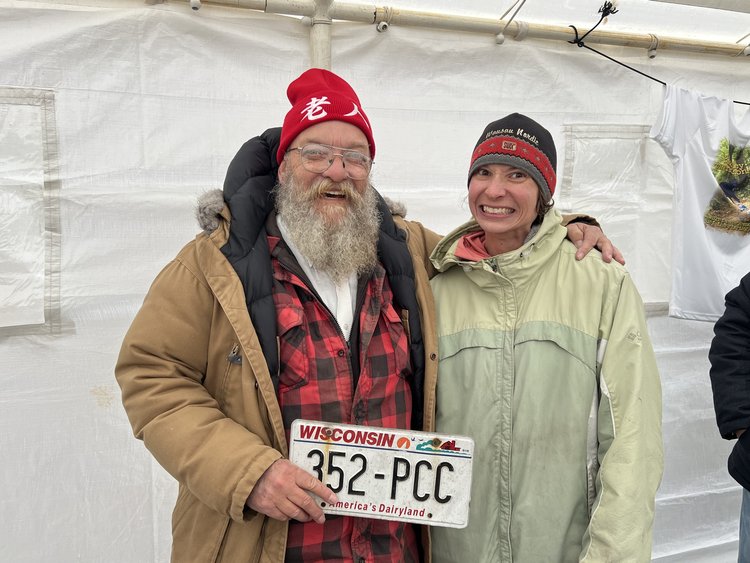
Andrea Larson took on the Barkley Marathons, one of the toughest running races around. It’s so tough, in fact, that until this year there hadn’t been a finished since 2017.
By B.C. Kowalski
Andrea Larson didn’t much sleep as she lay in her tent in a park in Tennessee.
Most racers at the Barkley Marathons don’t. That’s because there is no start time. At some point within a 24-hour period, the race’s creator, Laz, will blow the conch signaling all runners have an hour to make it to the start for the first of five laps in what is considered the toughest ultra-marathon race in the world.
So tough, in fact, that few finish it. Some years there aren’t any finishers at all. It’s easy to see why. Runners are signing up for a five-lap race of “20 miles” each (that’s the race’s official stance although in reality the laps are generally considered to be longer – some say each is closer to a marathon distance of 26 miles or so).
Nobody knows how long the laps actually are because no one is allowed to use GPS trackers or navigation. A compass and a map is all you get.
That GPS would be handy because you’re not really running a marked course. There’s sort of a general area the race roughly follows, and it changes every year, but each participant must find each of the course’s 11 books and rip out the page that corresponds with their bib number (so all the bib numbers are odd numbers).
It’s not a navigation race exactly, Larson explains, but navigation is a very important element.
When the conch did finally sound, Larson put her stuff together. She made her way to the start line knowing no woman had every completed the five loops, and few had completed the “fun run” — what they call completing three loops in the time allotted. No U.S. woman had done it.
Even getting into the race is a challenge. There isn’t exactly a sign-up form online. You have to write a letter convincing Laz that you ought to be one of the 40 runners in a race that has the habit of chewing up and spitting out even the most seasoned of ultra runners.
Larson definitely fits into that category. She’d already won a 50k North Face Ultra and had stunned herself when she finished the Leadville 100 in 24 hours to take fifth; about six hours faster than she’d expected. (She later returned to take third place.) She’s also won the Wausau24 mountain bike race, and the inaugural WausaUltra backyard race held at Sylvan Hill (repeating a just more than 4-mile course every hour on the hour until only one person can continue). There she beat everyone, man or woman.
After taking about eight years off from ultra running as she got married and had children, Larson entered the Marji Gesick 100-mile race and set a course record.
Not to mention that she’d also won the Barkley Fall Classic twice – it’s supposed to “guarantee” a spot in the Barkley Marathons. But, as she discovered, race officials still don’t just automatically send you the condolence letter that Laz sends out to people who are accepted into the race.
Amazingly, as Larson tells it, she still felt a bit of imposter syndrome at the start line surrounded by some legendary ultra runners.
All that would go out the window as Laz lit a cigarette to signal the start of the race — a race no one had finished since 2017.
Andrea Larson’s road to Barkley Marathons

Larson got into running in middle school and high school in Marathon, with her mother signing her up for practices. It was the first time cross country was offered at the school. “All I knew is that it was running in the woods,” Larson said from her Rib Mountain home. “And that was something that appealed to me.” That got her hooked, and helped introduce her to cross-country skiing as well.
Larson then joined the Michigan Tech cross country team. The engineering school typically had more men than women, and needed female athletes. It might be hard to believe given Larson’s accomplishments, but she says by her senior year the program had grown so much that she wouldn’t have made the team had she been a freshman then.
Michigan Tech was like a dream, she says, with world-class cross-country ski trails about a five-minute walk away (and campus five minutes away in the other direction).
Larson still follows the training style from her Michigan Tech team, logging her training hours on a spreadsheet. The same spreadsheet she used at the northern school. Adding in her high school training, Larson estimates she’s hit 10,000 hours of running in her career.
It’s not hard to believe, given the kind of training Larson describes later in the story.
After college, Larson wanted to stay active but realized her speed was declining. Instead of going for 5ks, she turned her attention to ultra-marathons.
For those not in the know, ultra marathons are any distance greater than the standard 26.2 miles, and unlike marathons they’re almost exclusive run on trails. Larson skipped the marathon and went right to ultras.
Her first ultra was the North Face challenge, a 50k distance (about 30 miles). Prior to that her longest run had been a half-marathon distance as part of a half-Ironman Triathlon. From there, she took to 50-mile races and then 100.
And to achieve those distances, she was running. A lot. Her husband back then didn’t think she wanted to date him because when he asked her out the first time, she declined because she had hill repeats to do.
Larson is selective with her races, but chose the Leadville 100, and ultra marathon related to one of the more famous mountain bike races (Lance Armstrong raced it following his road cycling career). She set a goal of finishing the 100-miler in 30 hours. So she was stunned to learn she’d actually finished in 24 hours and earned fifth place in the women’s division.
She finished so fast that she had to sit shivering in the cold for hours waiting for her crew person with her gear to arrive, because she’d expected to finish so much later and had no way to contact her.
Larson went back the next year in 2011 with the goal of winning. The ultra-marathon runner trained on Rib Mountain to improve her quads on the descent (descending while running might seem easier to non-runners but in reality your quads get quite the workout). But her quads still hurt and she ended up in third. She did go on to win the North Face Challenge 50-miler.
Eventually she did get married and had kids, and ultra marathons went on the backburner. She worked her engineering job at Siemens and raised her children. She still trained like crazy of course. But no races.
Then an interesting opportunity popped up.
And Iron opportunity for Andrea Larson

Bill Bertram, one of the founders of Ironbull, described to City Pages his job interview with Andrea Larson. He proposed to meet in a coffee shop in Rib Mountain. She skate skied to the meeting, and only drank water (those who know Larson know she doesn’t drink coffee or tea).
Bertram asked a pretty reasonable question: Why would she want to give up a high-paid career at Siemens to work for an athletic non-profit?
Larson told Bertram while she couldn’t change the world, she could change one community. “That was ours!” Bertram said she told him in that 2019 meeting.
So far so good, says Central Wisconsin Convention and Visitors Bureau Director Tim White. White says Andrea’s work on Ironbull and her outdoor athletic pursuits highlight exactly the outdoor recreation opportunities that make the area great.
“Having a world-class competitor like Andrea reinforces how unique Greater Wausau is as the perfect training ground,” White told City Pages. “The terrain, outdoor resource development and creature comforts of art, culture, dining and community feed the body and the soul.”
The time and flexible schedule with her new role allows Larson not only to focus more on her kids, but also to get training in. Two-a-day workouts turned into three-a-day and even four-a-day workouts. She runs repeats while she helps the kids to the bus. In training for Barkley, she describes ten-hour hill repeats on the southside trails on Rib Mountain, on a section locals describe as “stairway to hell,” because of its steepness.
After an eight-year absence from ultras, Larson is back.
Rib Mountain Adventure racing
Larson was invited to join the Rib Mountain adventure racing team. Adventure racing is a very different kind of sport – it involves navigation and multiple disciplines in a team environment.
Tim Buchholz, founder of the Rib Mountain Adventure Team and of Ironbull, said Larson’s worth ethic and athleticism quickly stood out to him.
Buchholz said despite that Larson is a humble, nice person. But she’s also incredibly driven. “When she puts her mind to something, I don’t think there is anything beyond her limits,” Buchholz told City Pages.
In putting together races for Ironbull, she came across a run called the Marji Gesick 100, a wilderness ultra marathon with a low finisher rate in Upper Michigan. That challenge appealed to Larson, and it became her first ultra in eight years.
Larson set a women’s course record in a year with a 24% finisher rate. Not too shabby from an eight-year layoff to get married and have children.
A lot had changed in those eight years. Everyone was now using GPS tracking and trail running shoes had gotten much lighter, so Larson uses them now. And everyone seems to have a coach now. And there are plenty more races to choose from now.
Larson herself has only done 13-14 ultra races in her career, she says. She’s very selective of which ones she participates in. But one she definitely had on her agenda: The Barkley Marathons.
The Barkley Marathons challenge
Andrea stepped to the start line knowing that no woman had ever finished the course. Were she to have finished three laps, considered a “fun” run, she’d be the first U.S. woman to do so. (British runner Jasmin Paris is latest to finish the fun run, and the first to start a fourth lap.)
To get to the start line, she’d won the Barkley Fall Classic twice (not realizing the first time that though you’re guaranteed a spot in the marathons with a win, you still have to do quite a bit of legwork to figure out just how you sign up for this mysterious race). She scouted the course, spoke with past runners, dug up as much info online as she could, and worked with the navigator on her adventure team.
The Barkley notably has no marked course, and runners must find books along the way, tearing out a page that corresponds with their bib number. Runners present their pages to Laz, the race director, at the end of the lap to verify completion of the course. (Some drama occurred this year when a day hiker took one of the books not knowing it was part of the race.)
Larson when she met Laz she acted non-chalantly. People typically get their photo taken with him, but when Larson was asked if she wanted a photo with Laz, she non-chalantly said “I guess so.”
I reached out to Laz to see if he remembered Larson and her nonchalant response. Laz told me he was in New Zealand for a race and wasn’t sure if he’d be able to get back to me in time. He ultimately had this to say about Larson, which showed up in my inbox in verse form right before the print version wrapped up:
andrea showed great ability at the barkley fall classic,
but the barkley is something of a different animal.
the first time out really only shows the skill sets required
and the tremendous amount of climbing and descending involved.
the real test will be a second attempt
to see how well she processed the lessons of the first experience.
Lazarus Lake, Barkely Marathons founder
Even lap one proved challenging. Larson had hoped to stick with some veterans of the course, since they would likely know the course better than she. The main pack lost her at the first climb. After the first book she found herself with only one other “virgin” (the race’s name for first-time competitors). Her initial plan went out the window.
But her navigation skills proved sufficient. She soon found herself back on track, making it back to the first lap with time to spare. Then, both her count of pages and Laz’s were one short of the number. Had she skipped a book?
Larson searched the ground and through the folded-up pages. The missing page wedged itself amongst the others. She was going to make it to loop two.
Unfortunately, during the course she had a chance to run with two faster runners and leave a more conservative group of four. She decided to play it safe, but that decision ultimately cost her and she ended up missing the time cutoff for the second lap by minutes.
“It’s bittersweet,” Larson says. “Looking back now, it’s how many places could I have saved a few minutes and officially finish the second lap. But I did accomplish something, I collected all the books for the second loop.”
Looking ahead
Larson describes feeling “being a little lost” post-Barkley. With no race on the horizon, she’s enjoying time with family and doing more fat biking and cross country skiing. She’s not sure if she’d try one again, considering all the scouting, training, info-gathering and time involved in doing something as challenging as the Barkley.
But overall, she looks favorably on the challenge. “It was more about the journey,” Larson says. “The opportunity to spend 11 1/2 hours on Rib Mountain a couple of times doing repeats is something I never thought I could physically or mentally do. That’s an accomplishment that can never be taken away.”
Read part I and part II of Larson’s much more detailed writeup of her Barkely Marathons experience (Photos in this piece courtesy of Larson).
Read next: Extreme sports push



